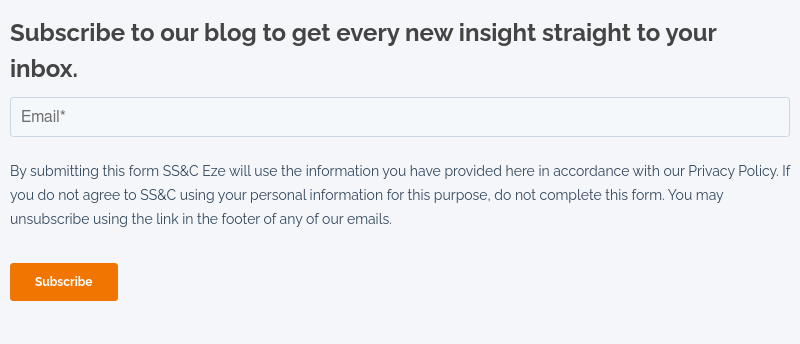As they balance optimism and uncertainty, asset managers seek to diversify. Learn how to overcome the challenges they face in doing so.
In its Global Financial Stability Report, the International Monetary Fund (IMF) presented a mixed update on the state of the global economy.
Despite a slowdown in global economic activity, the IMF confirms that a global recession has been successfully avoided and that the “soft landing” economists had been hoping for has been achieved.
And while that is good news, the IMF still has concerns about the speed at which inflation is coming down and what central banks will do to get inflation back on target.
Moreover, despite compressed volatility, fundamental uncertainty remains elevated across asset markets. Geopolitical tensions and other economic headwinds could lead the IMF to reassess the economic situation in the near future.
To retain their competitive advantage amid these uncertain outlooks, we see asset managers expanding from their traditional asset classes into a variety of others, including fixed income, digital assets, private credit, and loans.
However, as they expand into new assets, investment firms must ask this fundamental question: Can my existing technology support these new asset types?
In this post, I’ll explore the biggest technology challenges asset managers face when adding asset classes – and how to overcome them.

Technology Challenges Facing Asset Managers Adopting New Asset Classes
1. Selecting a Multi-asset Technology Platform
The technology landscape has changed, and firms have more technology options today than in the past. There’s no longer just one “best-of-breed” system for each asset class or business area.
This technical innovation has spawned a proliferation of new, specialized vendors that are very good at what they do. There are also many more “integrated,” “all-in-one,” or “front-to-back” solutions to choose from.
These solutions may provide a great breadth of coverage but fall short compared to “best-of-breed” systems if there are limitations in certain areas, like trading or compliance.
Whether you go with best-of-breed, all-in-one, or some combination of the two, you need to be able to seamlessly connect your data and systems into a single investment experience.
Look for extensible APIs, interoperability, and systems that feature off-the-shelf connectivity options for your trading and other partners.
The best all-in-one systems have the flexibility to hook into more specialized providers if you want to use them. Going all-in-one today shouldn’t limit your ability to integrate best-of-breed tools in the future.
Additionally, your system should be built with the technical underpinnings to rapidly innovate and enhance features and functionality while providing the flexibility to scale with you as you grow.
Keeping these features in mind as you select your multi-asset class investment system can save you the cost and hassle of switching systems down the line.
Need help making sense of the front-office options available today? Download our Trading Technology Buyer’s Guide.
2. Stepping Away from Automation & Increased Cost of Operation
Most asset managers spend years automating and refining automation of business-critical workflows to improve speed-to-market for investment decisions.
But, if your current system cannot support a fully automated end-to-end workflow, taking on additional asset classes can introduce new, labor-intensive processes and added operation costs that COOs and CTOs can’t justify unless it’s significantly outweighed by additional fund performance.
Although fear of hindering automation holds many firms back from trading less traditional asset classes, this doesn’t have to be the case. As each asset class requires different workflows, inputs, and data, your solution needs to perform each of the asset-specific nuances at scale.
With a technology solution that offers strong out-of-the-box asset-class coverage and flexibility in workflow customization, you’ll be able to more seamlessly adopt new asset classes and standardize workflows across your firm while still being able to customize them to your needs with ease.
This type of solution will not only cover the asset classes you’re trading today; it will also have the flexibility to grow with you as you adopt new asset classes in the future without impacting or interrupting your daily workflows.
3. Increased Market Data Costs
As firms expand into new assets, the importance of market data cannot be understated. Real-time, historical, summary, and reference data are crucial for activities such as trading, reporting, and auditing.
However, market data is one of the largest third-party costs for asset managers due in part to the natural monopoly exchanges have over market data. And with firms facing weak performance and margin pressures, there is less budget available for external market data costs.
However, in failing to introduce new asset classes for fear of incurring additional market data costs, firms run the risk of falling behind in terms of differentiation.
To rationalize costs, managers should seek out a data provider that offers optionality, so you are only paying for the data you need and none that you don’t.
To further rationalize costs, first understand your total cost of technology ownership with this calculation.
4. Assessing Risk for Decision Making
Managing downside risk has never been more important than in the current environment.
With existing solutions often focusing largely on traditional asset classes, the pre-trade decision support tools available are often limited to basic modeling/what-if analysis of a single asset class.
Investment decision-making is hard enough when you focus on a single asset class, but introducing derivatives and commodities makes portfolio analysis and conviction in decisions substantially more challenging.
As such, when diversifying asset classes, compliance managers and risk analysts need to ensure that pre-trade analysis and insights are actionable. Exposures need to be calculated quickly and on the fly, and your order management system needs to be flexible in terms of data aggregation and simulation of new positions across all asset classes.
To react quickly to market movement and corresponding events, managers need configurable analytics views built directly within their modeling tools, so the analytics they need are always at their fingertips.
5. Satisfying Investor Mandates
The past few years have brought about many changes in investment management practices and best practices. One example is a new standard of compliance. Today, investors have even more heightened awareness and expectations regarding risk and compliance.
Managing multiple asset classes across disparate systems or relying on manual workflows leaves room for error regarding compliance. Especially once you take on additional asset classes, operating on legacy platforms or utilizing manual compliance processes, like Excel, will not suffice.
Ideally, asset managers will build out an institutionalized compliance structure that simplifies the process with automated pre-, intra-, and post-trade alerts.
Tight integrations and streamlined workflows across systems should allow for heightened transparency and mitigated risk, while configurability and automated alerts will allow you to have confidence in your trading decisions and ability to meet investor mandates.
Additionally, your compliance tool should be flexible and built to scale alongside your firm, regardless of what asset classes you choose to trade down the line.
Market Leading Technology Supporting Asset Managers Through Persistent Low Yield Environment
Diversifying asset classes is a powerful strategy in uncertain markets, but it requires robust technology to manage risk and stay competitive.
By partnering with the right technology provider, asset managers can adapt their systems and optimize their strategies for outperformance.
SS&C offers comprehensive solutions to meet your diversification challenges. See how Eze’s multi-asset front-office solution supports investment firms in times of change.


